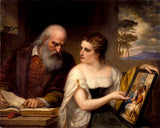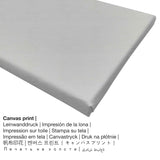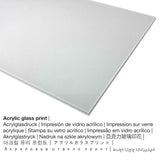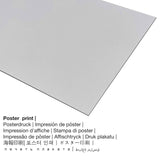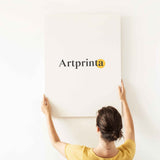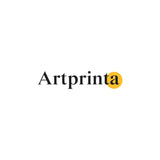Daniel Huntington, 1868 - Nkà ihe ọmụma na nka nke Ndị Kraịst - mbipụta nka mara mma
Ụtụ gụnyere. Mbupu gbakọrọ na ndenye ọpụpụ.
Mbipụta nka nkeonwe gị
Philosophy and Christian Art onye omenkà mere ya Daniel Huntington. The 150 Arụ ọrụ nka dị otu afọ na nha: 40 3/8 x 50 3/8 na (102,55 x 127,95 cm) ewe me ya ka ọ were ihe-ọcha mmanụ na kwaaji. Ọrụ nka bụ nke Ụlọ ihe ngosi nka nke Los Angeles County digital collection, which is the largest art museum in the western United States, with a collection of more than 142.000 objects that illuminate 6.000 years of artistic expression across the globe. This public domain artpiece is being included with courtesy of Ụlọ ihe ngosi nka nke Los Angeles County (www.lacma.org).: . N'elu nke ahụ, nhazi nke mmepụta dijitalụ na-abanye odida obodo format na nha nke 1.2: 1, nke pụtara na ogologo ya dị 20% ogologo karịa obosara.
Ngwa ngwaahịa a na-ahọpụta
In the dropdown lists next to the article you can select your individual material and size. Thus, we allow you to choose among the following options:
- Poster (akwa akwa akwa): A poster is a UV printed sheet of flat canvas with a nice finish on the surface, that resembles the original masterpiece. Please bear in mind, that depending on the absolute size of the poster we add a white margin of something between 2-6cm around the artwork in order to facilitate the framing with a custom frame.
- Mbipụta nke aluminom: An Aluminium Dibond print is a material with a true depth. For your Aluminium Dibond print, we print your chosen artwork right onto the aluminium surface. The colors of the print are luminous in the highest definition, the fine details are very clear, and you can feel the matte appearance of the art print surface.
- Mbipụta iko acrylic na-egbuke egbuke (nke nwere ezigbo mkpuchi iko): The acrylic glass print, which is sometimes referenced as a print on plexiglass, will transform your favorite original into lovely décor. Additionally, it is a good alternative option to canvas and aluminidum dibond prints. The work of art is being made with state-of-the-art UV direct printing machines. This has the impression of stunning, rich colors. The plexiglass protects your custom art print against light and external influences for many decades.
- Kwaaji: A printed canvas, not to be confused with an artwork painted on a canvas, is a digital copy printed from an industrial printer. A canvas of this artwork will let you turn your new art print into a large artwork. Canvas prints are relatively low in weight, which implies that it is easy and straightforward to hang up your Canvas print without any wall-mounts. A canvas print is suited for all kinds of walls.
Disclaimer: We try everythig possible to describe the art products as accurately as possible and to display them visually on the various product detail pages. Nevertheless, some colors of the printing material and the imprint might vary somehwat from the image on your device's monitor. Depending on the settings of your screen and the nature of the surface, not all color pigments can be printed as realistically as the digital version. Since the art reproductions are printed and processed manually, there might also be minor discrepancies in the exact position and the size of the motif.
Nkọwa ihe ahaziri ahazi
| Nkewa edemede: | nka nka |
| Usoro mmeghari: | dijitalụ mmeputakwa |
| Production usoro: | Mbipụta UV / dijitalụ |
| Production: | emepụtara na Germany |
| Stockdị ngwaahịa: | a na-achọ |
| Ojiji ngwaahịa: | ihe ndozi mgbidi, ihe ndozi ụlọ |
| Ndozi onyonyo a: | usoro odida obodo |
| Oke akụkụ: | 1.2: 1 |
| Mmetụta akụkụ onyonyo: | ogologo bụ 20% ogologo karịa obosara |
| Materials: | acrylic glass print (nwere ezigbo mkpuchi iko), mbipụta akwụkwọ mmado (akwụkwọ kwaaji), mbipụta ọla (aluminium dibond), mbipụta akwụkwọ. |
| Mpempe akwa akwa (akwa akwa na etiti ihe ndọtị) nha: | 60x50cm - 24x20", 120x100cm - 47x39" |
| Mbipụta iko acrylic (nwere ezigbo mkpuchi iko) dị iche iche: | 60x50cm - 24x20", 120x100cm - 47x39" |
| Nhọrọ nha nke akwụkwọ mmado (akwụkwọ kwaaji): | 60x50cm - 24x20", 120x100cm - 47x39" |
| Ụdị mbipụta aluminom dibond: | 60x50cm - 24x20", 120x100cm - 47x39" |
| ụba: | agunyeghi |
Data ndabere gbasara akụkụ nka mbụ
| Aha nka nka: | "Philosophy and Christian Art" |
| Nhazi nka nka: | sere |
| Category: | nkà nke oge a |
| Nhazi oge: | 19th narị afọ |
| Afọ okike: | 1868 |
| Afọ nka: | 150 afọ |
| Ọkara nke ihe osise izizi: | mmanụ na kwaaji |
| Akụkụ nke nka nka izizi: | 40 3/8 x 50 3/8 na (102,55 x 127,95 cm) |
| Ụlọ ihe ngosi nka: | Ebe ngosi nka nke Los Angeles County |
| Ebe ngosi nka: | Los Angeles, California, Njikota Obodo Amerika |
| Ebe nrụọrụ weebụ ihe ngosi nka: | Ebe ngosi nka nke Los Angeles County |
| Ikikere nke ihe osise: | ngalaba ọha |
| Site n'aka: | Ụlọ ihe ngosi nka nke Los Angeles County (www.lacma.org) |
Ozi omenka
| Ihe nkiri: | Daniel Huntington |
| Aha utu aha: | Daniel Huntington, onye. Huntington Daniel |
| okike onye nka: | nwoke |
| Obodo onye nka: | American |
| Ọrụ nke onye na-ese ihe: | onye na-ese ihe, onye na-ese ihe |
| Country: | United States |
| Otu nka: | omenkà nke oge a |
| Oge ndu: | 90 afọ |
| A mụrụ: | 1816 |
| Nwụrụ n'afọ: | 1906 |
© echekwabara ikike nwebiisinka, www.artprinta.com (Artprinta)
(© - Ụlọ ihe ngosi nka nke Los Angeles County - www.lacma.org)
Notes from the Curator: Although most of Huntington’s long career was taken up in painting more than one thousand portraits, he also painted landscapes and probably thought of himself as a painter of allegories and ideal subjects. His interest in religious and allegorical painting had been kindled by the Raphaelesque Italian and German ideal subjects he had seen in Rome on his first trip to Europe in 1839. By the 1860s his models were the Venetian artists of the High Renaissance, especially Titian (c. 1488-1576), whose example can be seen in the costumes and figure types depicted in Philosophy and Christian Art. The model or the type of the old man also appears in Huntington’s Sowing the Word, 1868 (New-York Historical Society). The influence of the Venetian school can also be seen in the rounder forms and richer palette of his paintings of this period. Even the halflength format seems to echo Venetian examples. The model for the painting to which the young lady gestures, however, appears to be The Adoration of the Shepherds, 1650, by José Ribera (1588-1652) in the Louvre, Paris. The painting is conceived as a conversation between embodiments of opposing, but equally worthy points of view. The wisdom of the aged scholar, reading a book by lamplight, is contrasted with the intuitive perceptions of the young woman who examines a work of art by the daylight signified by the window. Huntington has cast in terms of ideal figures one of the pressing problems of his own times, when scientific findings seemed to challenge the truth and wisdom of religion conveyed by artistic and other nonscientific forms of perception.
Notes from the Contributor: painting by Daniel Huntington (Museum: Los Angeles County Museum of Art)

